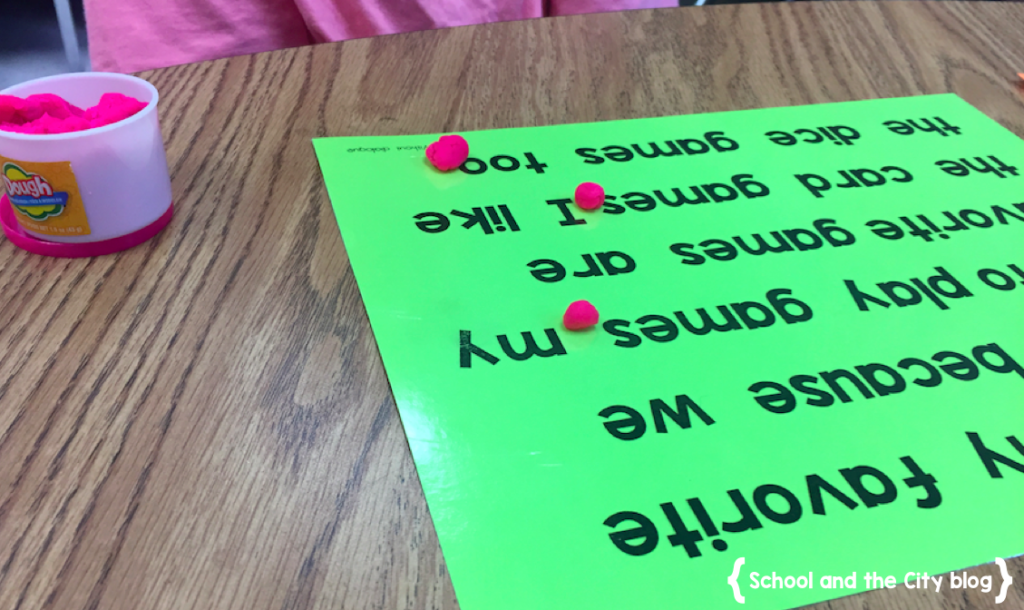What should students be working on independently while you teach small groups?
This is a question that is continuously asked in my building and on social media. As teachers, we recognize the importance of time. There’s never enough time to do it all, so it’s imperative that all time students spend at school is purposeful.
Below you’ll find many simple, evergreen ideas for word work centers that align with the science of reading research and evidence-based practices. Word work can include phonics, vocabulary, and comprehension.
No need to make copies each week – Place these in dry erase pockets or have students complete it using an online tool like Seesaw.

Phonics & Fluency
Sound-Spelling Mapping
Level up your spelling practice! Say goodbye to rainbow writing and hello to phoneme-grapheme mapping, which gets students thinking about the spelling patterns that match the sounds in words. Mapping is an opportunity to practice spelling words in a purposeful way. Teach students a simple routine (say it, stretch it, spell it) that they can use all year long.
Mapping is pretty simple for CVC words, but gets more challenging as we go through phonics skills. You can also use pictures, instead of a word list, which makes it even more challenging!

Boggle / Magic Squares
Kids love anything that resembles a game – and this is an easy one to make. I call it Boggle, but others call it “Magic Squares.” The idea is that students have 9 graphemes to choose from to create as many words as they can. Every word must include the grapheme that is in the middle box. You can task students with creating as many real words as they can, or have them sort real vs nonsense words as they make them. They’ll love this one, and you may even catch yourself trying to compete!

Phonics Fluency Games
I’ve previously written a blog post all about phonics fluency games. Once you teach them to your students, they can play independently using any word list. So fun!

Vocabulary
We know that vocabulary knowledge is necessary for skilled reading. (It even has its own strand on Scarborough’s Reading Rope!) Research indicates that vocabulary is directly correlated to reading comprehension and even other literacy skills like phonemic awareness. These extension activities should be done independently after a word has already been taught, encountered in text, etc. Vocabulary extension activities like these vocabulary maps can help students internalize and “own” the word. You can use words that appear in your RELA texts, or take the opportunity to make some cross-curricular connections!
Four Square
This activity is based on the Frayer Model. Using a Four Square map, students demonstrate their understanding of a word by writing its meaning, using it in a sentence, listing synonyms/antonyms, and illustrating.

Semantic Maps
This meaning map that I created is more complex than Four Square as it asks for many more layers of understanding such as analyzing word structure and related words, finding common contexts, and exploring multiple meanings. Choose your words strategically as this one will definitely be challenging for students.

Comprehension
Graphic Organizers
Did you know graphic organizers are evidence-based?
The purpose of after-reading activities, like story maps, is to allow students to communicate the content of a text in their own way so that they can embed it in their long-term memories. This is the creation of the mental model: reading the surface code (text) and making meaning. This deep processing leads to enduring understandings that will help students comprehend new texts later on that have similar structures, themes, or content.
Using graphic organizers to organize understandings after reading a fiction or nonfiction text is supported by research.

Syntax
Scrambled Sentences
Sentence structure can be tough for students to master, especially when starting from scratch like our littlest readers and writers! This scrambled sentences activity will have students thinking critically about sentence structure while having fun.
For an independent activity, students can practice writing the sentence on handwriting lines and illustrate to demonstrate understanding of what the sentence is saying.

Punctuation Placement
Are your students struggling to place punctuation marks in the correct spots? They may need more exposure and practice to develop syntactic awareness. Try giving students paragraphs without punctuation – It’s like a puzzle for them to solve!
Read more about this activity here.

Resources
- Phonics Fluency Strips
- Phonics Flash Cards
- Sound-Spelling and Syllable Mapping Templates
- Vocabulary Maps
- Scrambled Sentences
- Punctuation Placement
- Graphic Organizers for After Reading
You May Also Like…
- Try Word Chaining for Phonics Practice (includes a free download!)
- What is Orthographic Mapping? (includes a free download!)
- Teach Kids How to Decode Words
- Phonemic Awareness Bulletin Board
- Favorite Phonics Supplies from Amazon